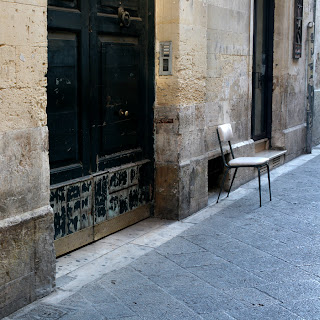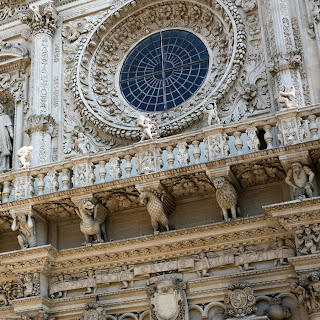
Last weekend was a whirlwind run through the heel of Italy. We touched down in Puglia and threw in a touch of Basilicata for good measure. And in our three days we confirmed what you'll hear over and over from all sides... the south is different.
In a way, you just want to say, duh. Of course a part of the country that is 400 miles south of where you live will be different. That's a little something we all learned about called geography -- and what you see out of your train windows is going to be different than what you see out of your train windows up north. Swap your rice paddies for scrubby groves of olive trees. Take your trackside poppies and trade them for gargantuan cactus bursting with fuschia fruit.
Vegetation aside, I'd say the more intriguing comparisons lie in the way standard systems, even though they are "systems," get a little more wiggly down south. For example, trains. Trains have a schedule. They come and go at certain times. A traveler can read posted signs and have access to the basics: the route, the stops, the timing. And, at least up north, you can usually find the train.

In Bari it was like Harry Potter trying to find the train to Hogwarts for the first time. Ours was due to take off from Track 7 very early in the morning. But when we showed up, very early in the morning, there was no Track 7 listed on any of the signs in the train station. Tracks 1-6 were very easy to find, clearly marked from all directions. But Track 7? Not one sign acknowledged its existence.
We eventually asked a train conductor who pointed towards the end of the station, past Track 6. Oh, of course! Down by Track 6! Even though all signs, in the whole station, show only 6 tracks at the station. So we went down past Track 6 and found the ever shy and modest Track 7.
It may sound silly but I assure you - in the nearly one and a half years we've spent in Italy, there has never been a train track we couldn't find. Because every train track has been labeled. If I were feeling bold I might even call it a "system," and I might even assert that this "system" is used worldwide to help people find their trains.

Other local diversions? How about playing "Unannounced Train Change?" This is where you have to get off of your train at a random station in the middle of nowhere and switch to another train simply because the train conductor told you to.
There's also a fun one we'll call "Quick, Get in the Other Car!" The goal of this little game is to be sure you're seated in a train car that will actually be leaving the station. Mind you, the number of cars actually attached to the locomotive changes along the way. To his credit the train conductor seems to have an eye on this and does an adequate amount of shooing folks into the right cars- otherwise we might still be sitting in an empty railcar in Puglia, waiting for the engine to come back and get us.
We spent a fair amount of time on the trains after our initial flight down to Bari due to our frenetic travel plans. In the span of three days we visited not only Bari, but also Matera, Lecce and Alberobello. Each has its own set of highlights and two of the four are designated UNESCO World Heritage Sites. Bari is a hectic grid of seaside commotion worth experiencing but we spent most of our time in the other towns.

Matera is known for its sassi. These are basic homes, clustered together, that have been carved out of the rocky terrain on which they congregate. These rock-hewn beehives are several thousand years old - the newest boasting a ripe young age of 1000. The big surprise comes with the realization that families were still living in these places until 1952 when the Italian government declared the sassi unsafe. The families were living without electricity or running water, but with their livestock. It wasn't a healthy combination.
You can visit the cave-like churches to see their frescoes but the most interesting stop is to one of the sassi that has been returned to its original conditions. You step in and realize that these cave homes can be larger than you'd expect - in this specific case, the rooms drop several levels into the earth. There was a space for the family, a space for the livestock, and a space for the provisions: the proximity of the three does much to explain how the space could be deemed unhealthy.
Wandering through the labyrinthine pathways you feel the sense of dusty abandonment that comes with towns that lack their inhabitants. But you also feel the sun beating on you - there's no shade - and the confusion that comes with wandering in a sun-bleached ghost town with no real streets or clear landmarks. I'm surprised that the film crews who have shot here, taking advantage of the biblical era scenary, have actually been able to find their way out.

We managed to find an exceptional lunch in the more modern and populated part of town. At Il Cantuccio (Via delle Beccherie) we had an antipasto sampler featuring incredible eggplant caponata, crispy peppers, zucchini with vinegar and fennel, and several other delicious little creations. My main dish was a very interesting flat & wide pasta served atop black bean puree, with hints of red pepper. Truly something we had never seen in Italy before. And so good.

Another highlight of Matera was the crafty wedding announcements that were stuck to every available surface. These xerox'd sheets announced weddings that were happening around town and touted the undying love of the happy couples. While some of these announcements featured photos of the couple canoodling, the serious artists of Matera used what I'm sure we can all agree is the worldwide symbol of everlasting love: poodles.

Lecce, down deep in the heel of Italy's boot, is a much larger town with a more sophisticated allure and a plethora of Baroque architecture. The churches are covered with opulent designs, there are Roman ruins in the town center and walking down the streets has a rather formalized air, especially with Lecce's stranglehold on the concept of the siesta. It's a ghost town for most of the afternoon; nearly everything closes and most everyone disappears. We were forced to follow suit and hole up in our hotel for a nap.

But in the early evening the town pours into the streets from every direction and takes to the passeggiata like true professionals. We had read about the mythical passeggiatta here but didn't believe it until we saw it. There was a remarkably steady flow of people languidly wandering down the streets. Except that they weren't wandering, they were following the same path as everyone else. Miraculous.

Lecce also has one of the finest pastry shops we've encountered in country. Natale Pasticceria on Via Trinchese had far too many choices but we did our best. We each picked a crème-filled giant and were amazed not only by the taste (a hallelujah moment) but also the price (1.50 each - hallelujah again). The fact that one of us ended-up covered in chocolate icing, and needed a water fountain to de-stick their sticky fingers, actually brought us to a gorgeous park filled with families where we enjoyed the Sunday festivities. Who knew pastries could be such amicable tour guides?

Alberobello is where the trulli are. Trulli are white conical homes that dot the countryside in this region. You see them start to pop up among the olive trees as your train nears town. These homes from the 17th century are supposedly designed to trick the tax collectors by resembling spaces used to house livestock and provisions - rather than the families who were actually living there. They're topped with stone ornaments of varying complexity and often have symbols whitewashed onto their conical roofs.

These structures are certainly unique and charming but be forewarned - they're also smack in the middle of a never-ending patch of sun and overrun by tourists. There are about 1500 of these small homes in Alberobello although a much smaller number of them are actually occupied by residents. You can, however, buy any number of souvenirs and knicknacks in them, and also find a pretty good cappucino.
In addition to the trulli, Alberobello has one of the best restaurants in Italy. It's called La Cantina (Vico Lippolis) and is, unsurprisingly, in what might be referred to as the basement. It's a small space with about 10 tables and at one end of the room is the kitchen. You watch the ingredients turn into your meal and it's absolutely wonderful.

We had an antipasto featuring a vast array of small plates with delicious foods - and they kept coming while we ate. Three kinds of salame, three kinds of cheese (including burrata the legendary cheese filled with cheese!), zucchini in oil, roast potatoes, tripe, focaccia, stuffed focaccia... and more. It was like a Christmas stocking where you keep finding things even though you thought you'd already found it all.

For our main plates we each ordered a fresh pasta complemented with the freshest of produce and cheeses. You can taste the difference at this place. It is not the norm and the standards far exceed what is normally great cooking across this country. Hand in hand, though, are the prices which are higher than usual for a lunch. Is it worth it, you ask? How fast can I say, "Hell yes! Go there now!"

Our trip was a great use of a long weekend. Although let me add a brief warning to anyone considering flying back up North at the start of September: don't do it. It seems to be prime time for families returning after their August vacations. Our plane was a flying, screaming kindergarten. We have never seen so many children on one plane and I think we can all agree that when one checks in at the airport they are not hoping for a seatmate who screams and refuses to sit still.
If only the airplanes were as hidden as the trains...





























